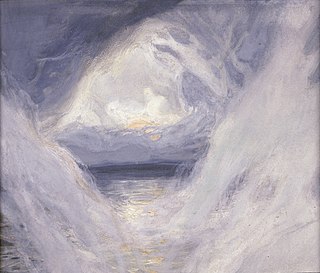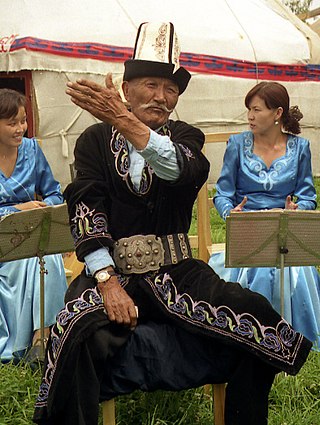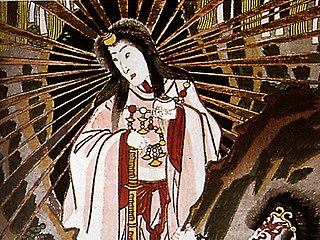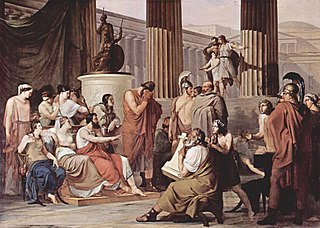Related Research Articles

A creation myth or cosmogonic myth is a type of cosmogony, a symbolic narrative of how the world began and how people first came to inhabit it. While in popular usage the term myth often refers to false or fanciful stories, members of cultures often ascribe varying degrees of truth to their creation myths. In the society in which it is told, a creation myth is usually regarded as conveying profound truths – metaphorically, symbolically, historically, or literally. They are commonly, although not always, considered cosmogonical myths – that is, they describe the ordering of the cosmos from a state of chaos or amorphousness.

The Osiris myth is the most elaborate and influential story in ancient Egyptian mythology. It concerns the murder of the god Osiris, a primeval king of Egypt, and its consequences. Osiris's murderer, his brother Set, usurps his throne. Meanwhile, Osiris's wife Isis restores her husband's body, allowing him to posthumously conceive their son, Horus. The remainder of the story focuses on Horus, the product of the union of Isis and Osiris, who is at first a vulnerable child protected by his mother and then becomes Set's rival for the throne. Their often violent conflict ends with Horus's triumph, which restores maat to Egypt after Set's unrighteous reign and completes the process of Osiris's resurrection.

A legend is a genre of folklore that consists of a narrative featuring human actions, believed or perceived to have taken place in human history. Narratives in this genre may demonstrate human values, and possess certain qualities that give the tale verisimilitude. Legend, for its active and passive participants, may include miracles. Legends may be transformed over time to keep them fresh and vital.

Oral tradition, or oral lore, is a form of human communication in which knowledge, art, ideas and culture are received, preserved, and transmitted orally from one generation to another. The transmission is through speech or song and may include folktales, ballads, chants, prose or poetry. The information is mentally recorded by oral repositories, sometimes termed "walking libraries", who are usually also performers. Oral tradition is a medium of communication for a society to transmit oral history, oral literature, oral law and other knowledge across generations without a writing system, or in parallel to a writing system. It is the most widespread medium of human communication. They often remain in use in the modern era throughout for cultural preservation.

Inuit religion is the shared spiritual beliefs and practices of the Inuit, an indigenous people from Alaska, northern Canada, parts of Siberia, and Greenland. Their religion shares many similarities with some Alaska Native religions. Traditional Inuit religious practices include animism and shamanism, in which spiritual healers mediate with spirits. Today many Inuit follow Christianity ; however, traditional Inuit spirituality continues as part of a living, oral tradition and part of contemporary Inuit society. Inuit who balance indigenous and Christian theology practice religious syncretism.

Toni Cade Bambara, born Miltona Mirkin Cade, was an African-American author, documentary film-maker, social activist and college professor.

Japanese mythology is a collection of traditional stories, folktales, and beliefs that emerged in the islands of the Japanese archipelago. Shinto traditions are the cornerstones of Japanese mythology. The history of thousands of years of contact with Chinese and various Indian myths are also key influences in Japanese religious belief.

A griot is a West African historian, storyteller, praise singer, poet, and/or musician.

The Ulster Cycle, formerly known as the Red Branch Cycle, is a body of medieval Irish heroic legends and sagas of the Ulaid. It is set far in the past, in what is now eastern Ulster and northern Leinster, particularly counties Armagh, Down and Louth. It focuses on the mythical Ulster king Conchobar mac Nessa and his court at Emain Macha, the hero Cú Chulainn, and their conflict with the Connachta and queen Medb. The longest and most important tale is the epic Táin Bó Cúailnge. The Ulster Cycle is one of the four 'cycles' of Irish mythology and legend, along with the Mythological Cycle, the Fianna Cycle and the Kings' Cycle.

Scottish mythology is the collection of myths that have emerged throughout the history of Scotland, sometimes being elaborated upon by successive generations, and at other times being rejected and replaced by other explanatory narratives.

Brazilian mythology is a rich and diverse part of Brazilian folklore with cultural elements, comprising folk tales, traditions, characters, and beliefs. The category is representative of Brazil’s greater culture, being a melting pot of Iberic traditions brought by the Portuguese settlers, African traditions brought by Africans during the colonial slave trade, and the traditions and stories of indigenous groups that have occupied Brazil for centuries.
Caribbean folklore includes a mix of traditions, tales, and beliefs of the Caribbean region. Caribbean folklore was shaped by a history filled with violence, colonialism, slavery, and multicultural influences. Specifically, influences from African, Creole, Asian, Indigenous American, European, and Indian cultures converged in the Caribbean to create a blend of lore unique to the region. Caribbean folklore has a variety of different characters that portray different traits. Folklore has evolved by blending folk speech, Creole dialogue, and various other elements that create the literary form of folklore, which portrays the "spirit" and "soul" of the Caribbean. Many themes are covered in Caribbean folklore, including colonial legacies, diversity in cultures, and the search for identity. Writers such as Nalo Hopkinson use these folklore elements in their writings by weaving myths and traditions into their modern-day storytelling.
Traditional stories, or stories about traditions, differ from both fiction and nonfiction in that the importance of transmitting the story's worldview is generally understood to transcend an immediate need to establish its categorization as imaginary or factual. In the academic circles of literature, religion, history, and anthropology, categories of traditional story are important terminology to identify and interpret stories more precisely. Some stories belong in multiple categories and some stories do not fit into any category.

In mythology and the study of folklore and religion, a trickster is a character in a story who exhibits a great degree of intellect or secret knowledge and uses it to play tricks or otherwise disobey normal rules and defy conventional behavior.

Egyptian mythology is the collection of myths from ancient Egypt, which describe the actions of the Egyptian gods as a means of understanding the world around them. The beliefs that these myths express are an important part of ancient Egyptian religion. Myths appear frequently in Egyptian writings and art, particularly in short stories and in religious material such as hymns, ritual texts, funerary texts, and temple decoration. These sources rarely contain a complete account of a myth and often describe only brief fragments.

In Hindu mythology, there are deities or heroes whose attributes or behavior can be interpreted as lesbian, gay, bisexual, or transgender (LGBTQ) or have elements of gender variance and non-heterosexual sexuality. Traditional Hindu literary sources do not speak of homosexuality directly, but changes of sex, homoerotic encounters, and intersex or third gender characters are often found both in traditional religious narratives such as the Vedas, Mahabharata, Ramayana and Puranas as well as in regional folklore.

Myth is a genre of folklore consisting primarily of narratives that play a fundamental role in a society. For scholars, this is very different from the vernacular usage of the term "myth" that refers to a belief that is not true. Instead, the veracity of a myth is not a defining criterion.

Malay folklore refers to a series of knowledges, traditions and taboos that have been passed down through many generations in oral, written and symbolic forms among the indigenous populations of Maritime Southeast Asia (Nusantara). They include among others, themes and subject matter related to the indigenous knowledge of the ethnic Malays and related ethnic groups within the region.
Canadian folklore is the traditional material that Canadians pass down from generation to generation, either as oral literature or "by custom or practice". It includes songs, legends, jokes, rhymes, proverbs, weather lore, superstitions, and practices such as traditional food-making and craft-making. The largest bodies of folklore in Canada belong to the aboriginal and French-Canadian cultures. English-Canadian folklore and the folklore of recent immigrant groups have added to the country's folk.

The Hero Twins are recurring characters from the mythologies of the indigenous peoples of the Americas. The specifics of each myth vary from tribe to tribe, but each story has a pair of twins who were born when their pregnant mother was killed by the tale's antagonist. Twins were considered unnatural in many cultures of this region, with beliefs about them having supernatural abilities.
References
- 1 2 3 4 5 Chevrier (2005), p. 54.
- 1 2 3 4 Chevrier (2005), p. 55.
- ↑ Laura C. Jarmon (2003). Wishbone: Reference and Interpretation in Black Folk Narrative. University of Tennessee Press. pp. 33–34. ISBN 978-1-57233-273-7.
- ↑ Patricia Ann Lynch; Jeremy Roberts (2010). African Mythology, A to Z. Infobase Publishing. p. 41. ISBN 978-1-4381-3133-7.